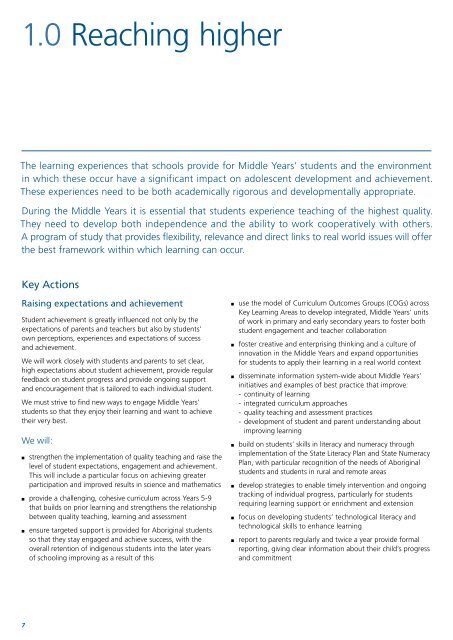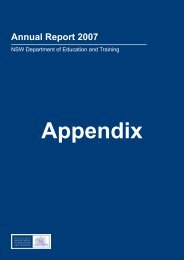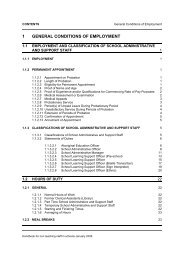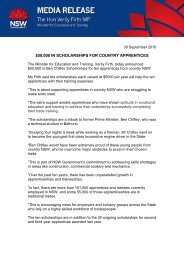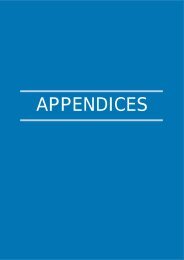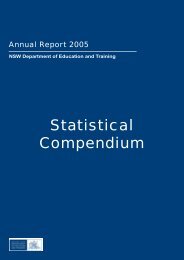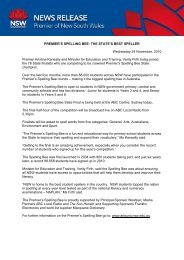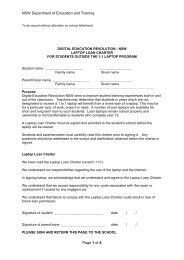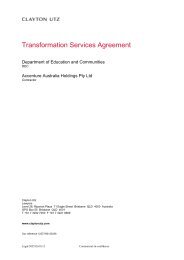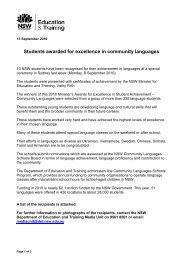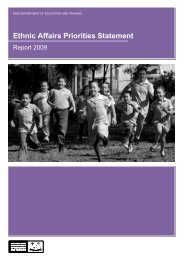Our Middle Years - Department of Education and Communities ...
Our Middle Years - Department of Education and Communities ...
Our Middle Years - Department of Education and Communities ...
- No tags were found...
Create successful ePaper yourself
Turn your PDF publications into a flip-book with our unique Google optimized e-Paper software.
1.0 Reaching higherThe learning experiences that schools provide for <strong>Middle</strong> <strong>Years</strong>’ students <strong>and</strong> the environmentin which these occur have a significant impact on adolescent development <strong>and</strong> achievement.These experiences need to be both academically rigorous <strong>and</strong> developmentally appropriate.During the <strong>Middle</strong> <strong>Years</strong> it is essential that students experience teaching <strong>of</strong> the highest quality.They need to develop both independence <strong>and</strong> the ability to work cooperatively with others.A program <strong>of</strong> study that provides flexibility, relevance <strong>and</strong> direct links to real world issues will <strong>of</strong>ferthe best framework within which learning can occur.Key ActionsRaising expectations <strong>and</strong> achievementStudent achievement is greatly influenced not only by theexpectations <strong>of</strong> parents <strong>and</strong> teachers but also by students’own perceptions, experiences <strong>and</strong> expectations <strong>of</strong> success<strong>and</strong> achievement.We will work closely with students <strong>and</strong> parents to set clear,high expectations about student achievement, provide regularfeedback on student progress <strong>and</strong> provide ongoing support<strong>and</strong> encouragement that is tailored to each individual student.We must strive to find new ways to engage <strong>Middle</strong> <strong>Years</strong>’students so that they enjoy their learning <strong>and</strong> want to achievetheir very best.We will:■■■strengthen the implementation <strong>of</strong> quality teaching <strong>and</strong> raise thelevel <strong>of</strong> student expectations, engagement <strong>and</strong> achievement.This will include a particular focus on achieving greaterparticipation <strong>and</strong> improved results in science <strong>and</strong> mathematicsprovide a challenging, cohesive curriculum across <strong>Years</strong> 5-9that builds on prior learning <strong>and</strong> strengthens the relationshipbetween quality teaching, learning <strong>and</strong> assessmentensure targeted support is provided for Aboriginal studentsso that they stay engaged <strong>and</strong> achieve success, with theoverall retention <strong>of</strong> indigenous students into the later years<strong>of</strong> schooling improving as a result <strong>of</strong> this■■■■■■■use the model <strong>of</strong> Curriculum Outcomes Groups (COGs) acrossKey Learning Areas to develop integrated, <strong>Middle</strong> <strong>Years</strong>’ units<strong>of</strong> work in primary <strong>and</strong> early secondary years to foster bothstudent engagement <strong>and</strong> teacher collaborationfoster creative <strong>and</strong> enterprising thinking <strong>and</strong> a culture <strong>of</strong>innovation in the <strong>Middle</strong> <strong>Years</strong> <strong>and</strong> exp<strong>and</strong> opportunitiesfor students to apply their learning in a real world contextdisseminate information system-wide about <strong>Middle</strong> <strong>Years</strong>’initiatives <strong>and</strong> examples <strong>of</strong> best practice that improve:- continuity <strong>of</strong> learning- integrated curriculum approaches- quality teaching <strong>and</strong> assessment practices- development <strong>of</strong> student <strong>and</strong> parent underst<strong>and</strong>ing aboutimproving learningbuild on students’ skills in literacy <strong>and</strong> numeracy throughimplementation <strong>of</strong> the State Literacy Plan <strong>and</strong> State NumeracyPlan, with particular recognition <strong>of</strong> the needs <strong>of</strong> Aboriginalstudents <strong>and</strong> students in rural <strong>and</strong> remote areasdevelop strategies to enable timely intervention <strong>and</strong> ongoingtracking <strong>of</strong> individual progress, particularly for studentsrequiring learning support or enrichment <strong>and</strong> extensionfocus on developing students’ technological literacy <strong>and</strong>technological skills to enhance learningreport to parents regularly <strong>and</strong> twice a year provide formalreporting, giving clear information about their child’s progress<strong>and</strong> commitment7


